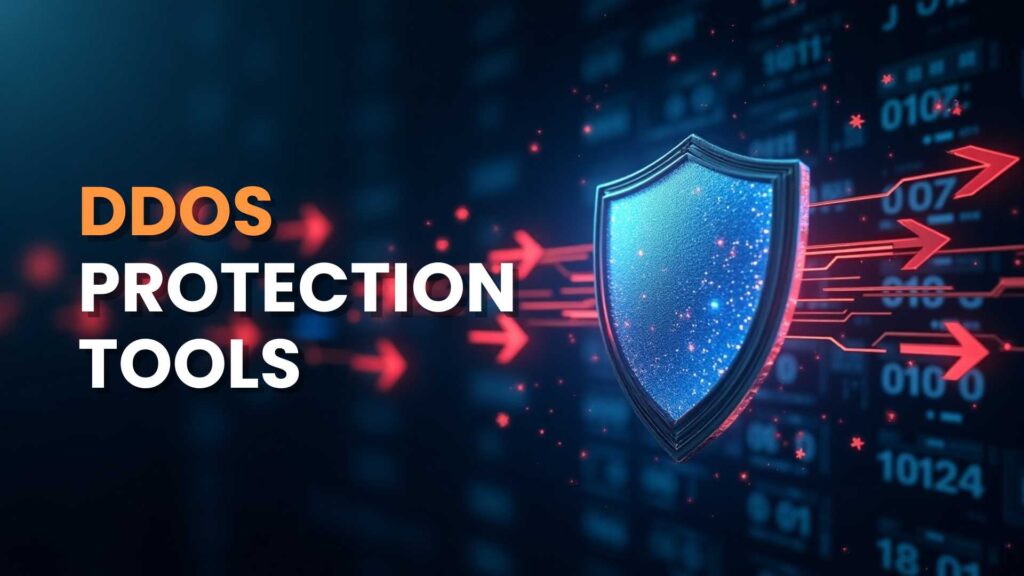Distributed Denial of Service attacks are more powerful and malicious to businesses in the world today, as the world becomes more integrated when it comes to a digital sphere. With cybercriminals advancing new methods of interfering with the online services, the institutions will have to invest in the best DDoS Protection Tools to protect their digital infrastructure. The aforementioned security solutions are just the tip of the iceberg in terms of securing against badly aimed floods of traffic that may down websites, applications, and even the network.
As DDoS attacks have become both more frequent and more daunting due to the importance and upshots of DDoS protection, the choice of protection tools has become paramount in retaining business continuity, revenue as well as confidence in a highly competitive online business environment.
What is a DDoS Attack?
Distributed Denial of Service attack is an unwanted effort to interrupt useful activity of a target server, service, or network by draining it with a huge amount of internet traffic through numerous hacked devices. As opposed to conventional network attacks which use a single source of attacks, DDoS attacks use networks of infected devices referred to as botnets to produce huge traffic volumes capable of exhausting the resources of targets. The purpose of such attacks is to render online kinds of services unavailable to their legitimate users through the consumption of valuable bandwidth, server resources or network infrastructure capacities.
The DDoS Protection Tools are very specialized to detect the attacks, filter them and mitigate them before serious damage can be done. DDoS attacks have become highly sophisticated and have integrated artificial intelligence and machine learning in order to overcome established security systems to have the optimum impact.
Why DDoS Protection is Essential in 2025
The most recent historical events stimulated the digital transformation to a completely new level and now every organization is more reliant on online services than ever before, and the serious levels of DDoS protection is becoming an absolute must in order to be able to survive in business.
- Sophistication: The new generation of attacks is equipping themselves with artificial intelligence and machine learning to evade bypass detection systems automatically.
- Scale: The scale of current attacks is higher than ever before and some attacks have well surpassed terabytes per second of malicious traffic.
- Frequency: Organizations are experiencing an average of more than several per month and hence require a vigilant protective measure.
- Cost: Proper DDoS can cost the organization millions of dollars, in terms of lost revenue, the image and recovery expense.
- Compliance: Documented DDoS protection measures are also becoming a regulatory requirement that a variety of industries have to follow in order to comply with security standards and frameworks.
Types of DDoS Attacks
DDoS attacks can be roughly divided into volumetric, protocol, and application layer attacks each one of which has its own target on network infrastructure and necessitates a specific way of defense.
Volumetric Attacks
Volumetric attacks are the most widespread type of DDoS attack and are aimed at capturing the bandwidth of a target by means of flooding it with traffic. Most of these attacks gauge the success by bits per second and are usually nominal to saturate or overrun the link between the target and the internet. The volumetric attacks that are common are UDP flood, ICMP flood and amplification attacks which use the publicly available servers to amplify the attack traffic. DDoS Protection Tools prevents such attacks by filtering the traffic, limiting the rate, and associating with internet service providers in upstream filtering.
Protocol Attacks
Protocol attacks, take advantage of flaws in network protocols and other components of the network infrastructure, and attack server resources as well as intermediate communication devices such as firewalls and load balancers. These attacks do not use bandwidth but eat up the resources the server has in the form of connection state tables, processing power and memory. SYN floods, Ping of Death, and fragmented packet attacks are some of the popular protocols used in attacking connections, which are overwhelmed by packets. Effective DDoS Protection Tools can deal with protocol attacks in the form connection limiting, protocol-validation and resource-management methods.
Application Layer Attacks
Application layer attacks are the most advanced type of DDoS attacks that are aimed at certain applications and services as opposed to the network infrastructure. These attacks involve impersonating legitimate user activities and thus they are very hard to identify and block through normal security controls. Examples of common application layer attacks are HTTP floods, Slowloris attacks and API abuse which consume the applications resources, but do not look like normal traffic patterns. Highly intelligent DDoS Protection Tools fight these attacks based on behavioral analysis and application fingerprinting and with intelligent traffic classification algorithms.
Key Features to Look for in DDoS Protection Tools
To choose an effective DDoS protection, it is necessary to know what features to look at which will distinguish complex and general security solutions, and simple traffic filtering systems in the modern threat environment.
- Detection: Sophisticated algorithms of detection of attacks that identify attack patterns based on machine learning algorithms, and behavior analysis.
- Mitigation: The automatized response system capable of preventing malicious traffic and ensuring accessibility of services to genuine users.
- Scalability: Infrastructure the capability to handle extremely high rates of attack without undermining the efficacy of protection or the good user experience in a genuine utilization.
- Integration: Perfect fit between the existing security framework, content delivery networks and clouds so as to offer end-to-end security.
- Analytics: Reporting and real-time dashboards that provide a view of attack patterns, mitigation effectiveness, and security postures.
Comparison Table: DDoS Tools at a Glance
| Tool | Deployment Type | Target Use Case | Pricing Tier | Support Level |
| A10 Thunder TPS | On-premises/Cloud | Enterprise Security | Premium | 24/7 Expert |
| CloudFlare | Cloud-based | Small to Enterprise | Budget to Premium | Standard/Premium |
| Fastly | Edge Cloud | Performance-focused | Premium | Developer Support |
| Imperva | Hybrid | Application Security | Mid to Premium | 24/7 Managed |
| F5 Silverline | Hybrid | F5 Ecosystem | Mid to Premium | Managed Services |
| Radware DefensePro | On-premises | High-performance | Premium | Expert Support |
| Arbor Networks | Hybrid | Threat Intelligence | Premium | Research-backed |
| Akamai Prolexic | Cloud-based | Large-scale Enterprise | Premium Plus | 24/7 Managed |
| Corero SmartWall | On-premises | Automated Protection | Budget to Mid | Standard |
| Azure DDoS Protection | Cloud-native | Azure Ecosystem | Mid to Premium | Microsoft Support |
Top 10 DDoS Protection Tools in 2025
1. A10 Thunder TPS
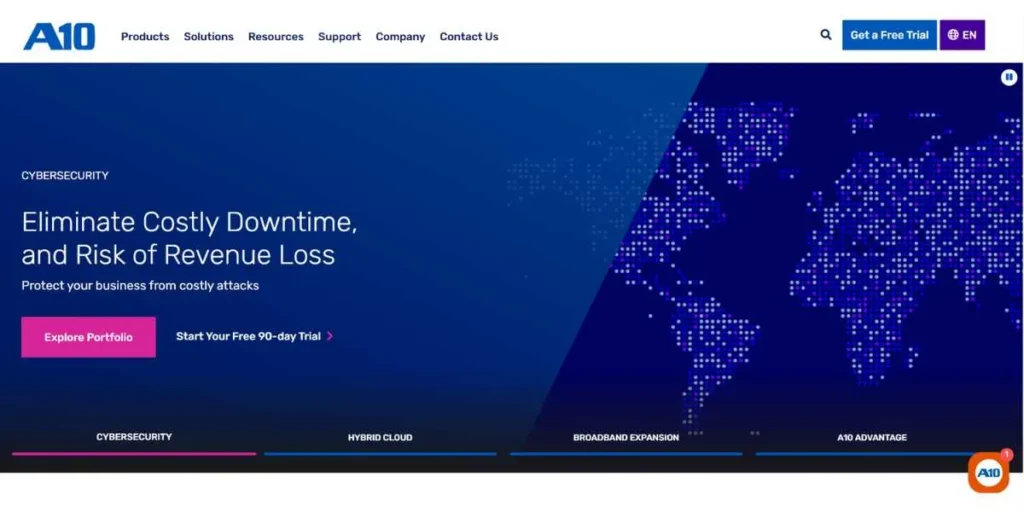
Rating: 4.7/5
Website: https://www.a10networks.com/
A10 Thunder TPS offers an all-inclusive and multi-vector protection against threats that are more focused on enterprises dealing with advanced DDoS attacks. It is a high-performance traffic processing security platform that integrates the power of vector processor-based traffic processing with advanced algorithms that detect volumetric, protocol, and application layer attacks in real-time. The solution includes machine learning that would adjust to new threat profiles without having large effects on the flow of legitimate traffic.
DDoS Protection Tools such as Thunder TPS can be of great value to all organizations that strive to exercise a lot of control over the security policies and get hold of in-depth attack analytics. The architecture of the platform is on-premises and cloud agnostic — allowing flexibility on a wide range of infrastructure needs whilst offering the same protection on every part of the network.
Key Features:
- Multi-vector protections against detection and mitigation of attacks
- Threat intelligence and pattern recognition based on machine learning
- Low latency of high-volume traffic processing
- Big data Large-scale Reporting and analytics dashboard
- Hybrid positioning options that are flexible
Pros:
- High false positive rates performance is excellent
- Threat intelligence and behavioral analysis
- High integrative features with available security system
Cons:
- Problems of initial set up and configuration requirements.
- More costly than low end protection products
- Needs skill to utilize it best
Pricing: Custom pricing
2. CloudFlare
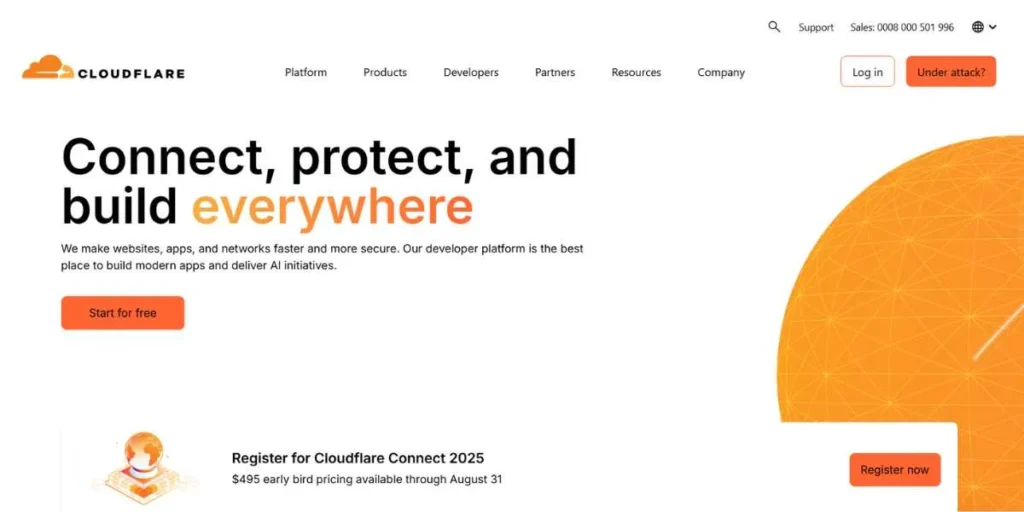
Rating: 4.8/5
Website: https://www.cloudflare.com/
CloudFlare is recognized to be a major provider of end-to-end network protection with a rich set of protective tools including a powerful DDoS mitigation. The platform uses a worldwide infrastructure of data facilities to consume and global filter malicious traffic prior to contact with the aim infrastructure. The security/protection systems created by CloudFlare make use of highly sophisticated algorithms combined with threat intelligence to differentiate between users that are legitimate users versus traffic representing the attacks without adversely affecting the performance of the valid users.
The benefits that come along with Modern DDoS Protection Tools such as CloudFlare, are the content delivery network services, the web application firewall features and the dynamic optimization features. The solution is based on the always-on type of protection and is able to monitor it 24 hours a day and respond to the emerging threats without manual intervention and configuration.
Key Features:
- Wide area network infrastructure of extended traffic uptakes
- Automated threat detection in always-on DDoS protection
- Embedded CDN and web application firewall functionalities
- Threat intelligence reporting and real time analytics
- Several gradations of service offering to meet the needs
Pros:
- Superb international coverage and network bandwidth
- Simple interface and complex configuration
- Proper optimization of performance and security features
Cons:
- Fewer choices of customization of advanced security policies
- Outsourcing to third party provider of essential safeguarding
- complex functions that involve an upgraded subscription plan
Pricing: From $20/user/month (billed annually)
3. Fastly
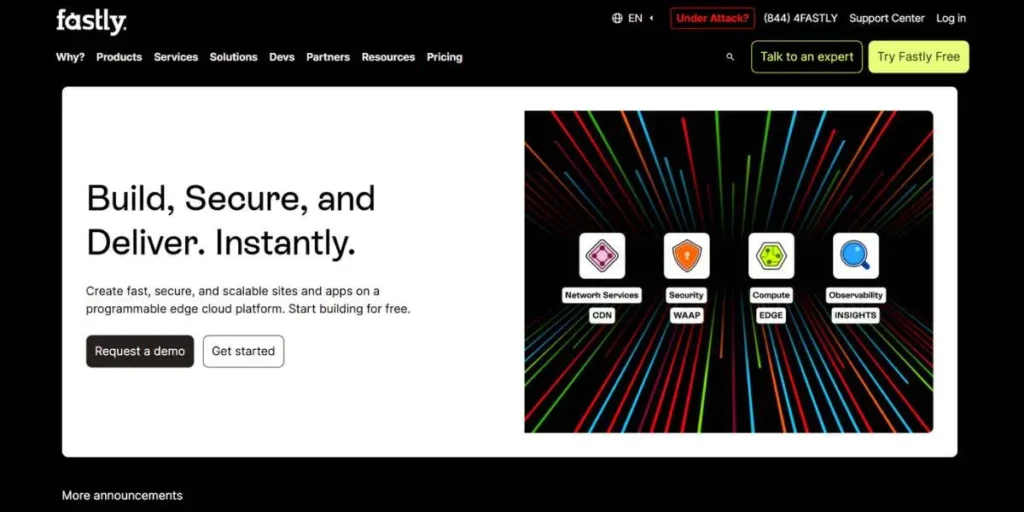
Rating: 4.6/5
Website: https://www.fastly.com/
Fastly is a specialist in edge cloud performance whose solutions integrate advanced features of DDoS protection into their offering content delivery system. The service offers a high-performance content delivery and ensures real-time threat detection to provide end-to-end protection against a wide range of attack vectors. The edge computing architecture by Fastly allows prompt reaction to any threats on the edge of the network which reduces the effects on the origin servers and preserves optimal user experience at the time of the attacks.
Companies adopting the DDoS Protection Tools of Fastly have access to the programmable edge properties, where they can develop specific security logic to protect their resources and deploy the dedicated anti-DDoS capabilities quickly. Real-time configuration features of the solution allow it to be responsive to the emergent threats rather than put a strain on the regular deployment time of the solution.
Key Features:
- DDoS detection and mitigation capabilities that are edge-based
- Dynamic security rules and self-written protection code
- Threat response and real-time updating of configuration
- Embedding content delivery and optimization of performance
- Having sound logging and analysis in security monitoring actions
Pros:
- High performance of the edges with minimum latencies
- Protection rules and security policies which can be highly customized
- Powerful development tools and API integration facilities
Cons:
- More complexity requiring technical expertise to maximize
- Limited customary business security management control panels
- High pricing in case of more custom features
Pricing: $50/mo + usage
4. Imperva
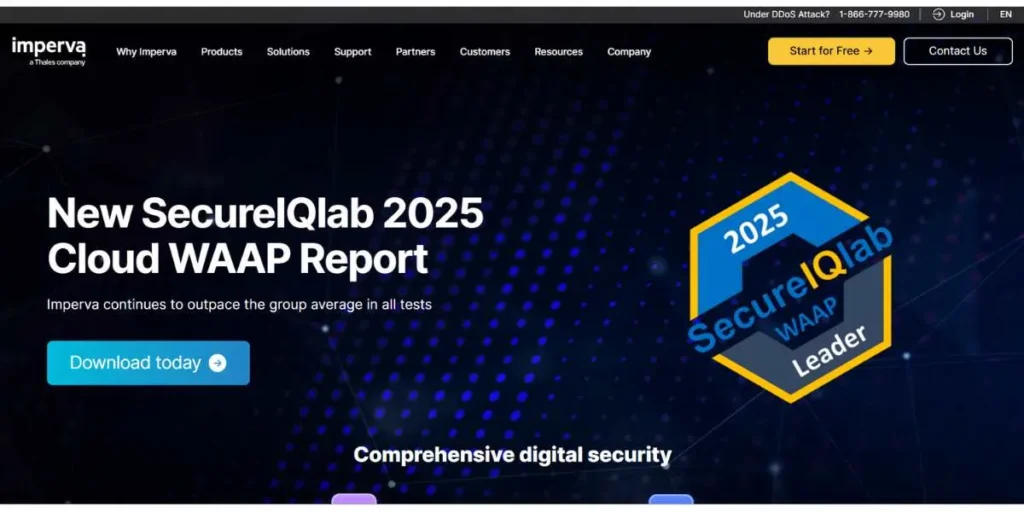
Rating: 4.7/5
Website: https://www.imperva.com/
Imperva specializes in application-level security, specifically offering protection against DDoS, as well as web application firewall and database protection services. The platform is very good at pattern recognition and detection of sophisticated application-layer attacks. Imperva protection mechanism is based on behavioral analysis and the use of machine learning to detect attack patterns and ensure that there is seamless user access to legitimate traffic.
Imperva and its peers offer enterprise-level DDoS protection tooling with extensive application security posture awareness, in the form of detailed reports and integrated threat intelligence. The hybrid deployment options of the solution allow hosting it in the cloud or on-premises, depending on the needs of an organization and its compliance regulations.
Key Features:
- The application-level DDoS protection and web application firewall
- Machine learning and behavioural analysis of threats
- An integrated database security and data protection set of functions
- Threat intelligence and security analytics integrative reporting
- The flexibility of hybrid deployment in order to meet different demands
Pros:
- Great protection and threat detection of the application-layer
- Portfolio of security services in addition to DDoS protection
- Compliance and regulatory requirement support in the right places
Cons:
- More expensive universal security feature set
- Complicated set-up to give best protection against the application
- High-level threat analysis proficiency Learning curve
Pricing: From $30/user/month with enterprise pricing available
5. F5 Silverline
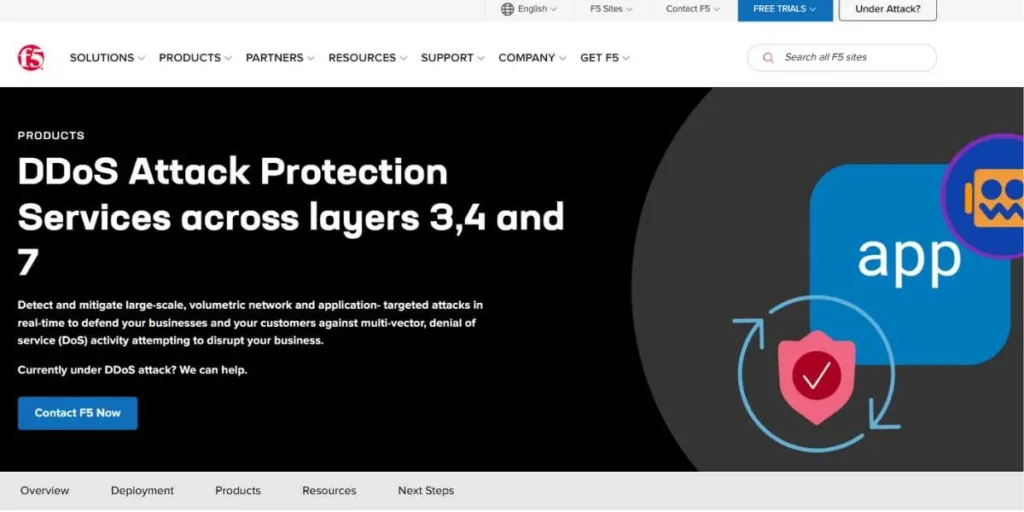
Rating: 4.5/5
Website: https://www.f5.com/
F5 Silverline is a high scalable defense solution that unites cloud-based and on-site defense to elevate DDoS defense. The platform will include an always-on protection component and an on-demand component so that organizations can choose level of protection that suits their threat status and budget allocations. Silverline is an architecture built on F5 security expertise allowing the global infrastructure, including edge cloud services as access points through the globe to create a scalable security address against DDoS threats that are also evolving.
Organizations that deploy DDoS Protection Tools offered by F5 have the advantage of the expertise of the company with regards to application delivery, as well as its ability to integrate with in place F5 infrastructure. The flexible service model of the solution addresses the diverse needs of the organizations, such as basic protection as well as fully managed security services.
Key Features:
- The architecture of cloud and on-premises hybrid protection
- Service options that offer flexibility
- Integration with the current F5 application delivery infrastructure
- Bound security services and professional reaction to threats
- Broad-scale reporting and security analytics abilities
Pros:
- Versatile service parameters that provide a solution to various needs
- Effective work with the current F5 investments in infrastructure
- Threat response and expert managed services
Cons:
- The pricing is complex with various levels of service offering
- The reliance on an F5 ecosystem to get maximum integration advantages
- Narrow self-familiar capabilities without a wider F5 buy-in
Pricing: Pricing available upon request based on service requirements
6. Radware DefensePro
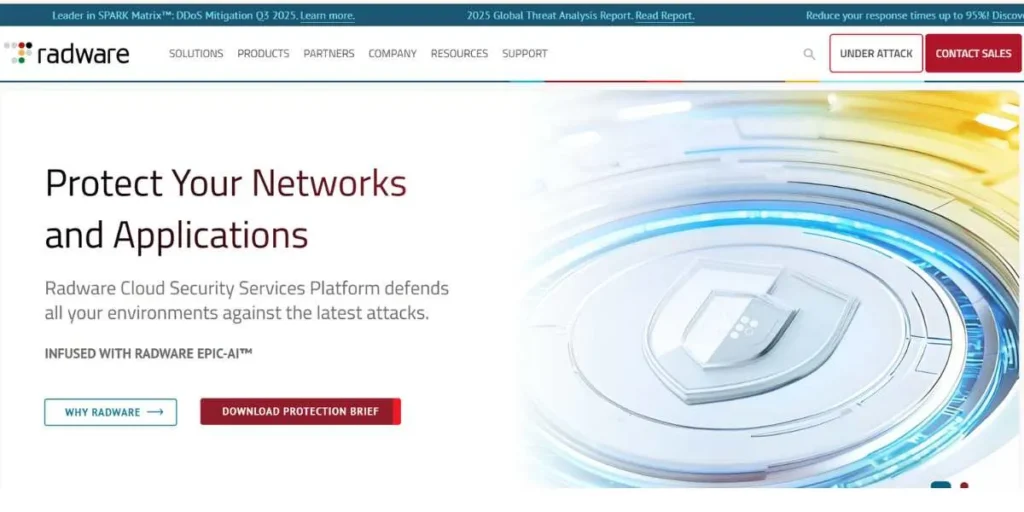
Rating: 4.6/5
Website: https://www.radware.com/
DefensePro DefensePro is a real-time mitigation-based solution to the prevention of attacks and provides DDoS protection by combining behavioural analysis and signature solutions. The platform has protection on both the network level and application level and adapts the changes in the threat patterns automatically with the help of machine learning techniques. The architecture of DefensePro is able to support high-throughput environments with low latency on legitimate traffic, thus able to support performance-sensitive applications.
State-of-the-art DDoS protection such as DefensePro provides a full combination of threat intelligence data as well as automated reaction mechanisms that reduce the amount of necessary manual intervention. The modular architecture of the solution enables an organization to add protection capacities to fit the needs that arise with time and increasing threats.
Key Features:
- Behavioral analysis is available in real-time and signature-based detection
- Broad protection functionality of the network and application layers
- Adaptive learning algorithms of responsive threats
- Processing at a very high throughput, which will have minimal latency effects
- Modular architecture with a scalable installation available
Pros:
- Excellent threats detection and response during real time
- End-to-end defense against a wide range of attack vectors
- Excellent performance attributes in high traffic areas
Cons:
- Multi-faceted deployment and configuration needs
- Advanced threat detection expensive services
- Continuous adjustment in order to provide maximum protection efficiency
Pricing: Pricing available upon request based on deployment requirements
7. Arbor Networks
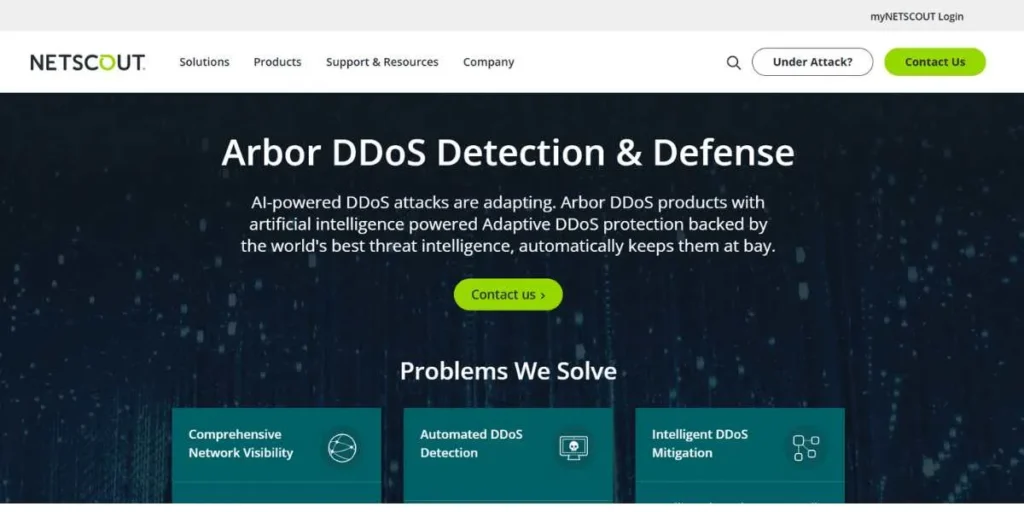
Rating: 4.4/5
Website: https://www.netscout.com/
Arbor Networks has established its reputation on offering a complete set of threats in the world of mitigation of DDoS threats through dedication of adequate threat detection catalog and therefore the widespread capacity to detect threats throughout the world. The platform integrates real time detection of attacks and historical pattern of threats providing predictive protection of emerging attack patterns. Arbor solutions combine threat intelligence with their global threat monitoring network to give customers the ability to defend against new attack vectors prior to their widespread adoption.
Customers using the DDoS Protection Tools by Arbor Networks have access to the immense development and research investments of the company in terms of attack analysis and threat intelligence capabilities. The architecture of the platform facilitates service provider and enterprise-based deployment, making it suitable for the needs of various organizations as well as network styles.
Key Features:
- An internationally based threat intelligence research service
- Malware recognition and anticipatory security systems in real time
- Integration with a worldwide threat monitoring and analysis network
- Both service provider and enterprise-based deployment Support
- Ideal reporting feature and analytical tools for threat
Pros:
- Research-based threat intelligence and security at its best
- Single worldwide image of the trend and patterns of attack
- Rather high brand name and record in the business of DDoS protection
Cons:
- Multifaceted integration demands to achieve the best use of threat intelligence
- Expensive to have full threat intelligence capability
- Steep learning curve of the advanced threat analysis and reporting capabilities
Pricing: Pricing available upon request based on deployment and intelligence requirements
8. Akamai Prolexic
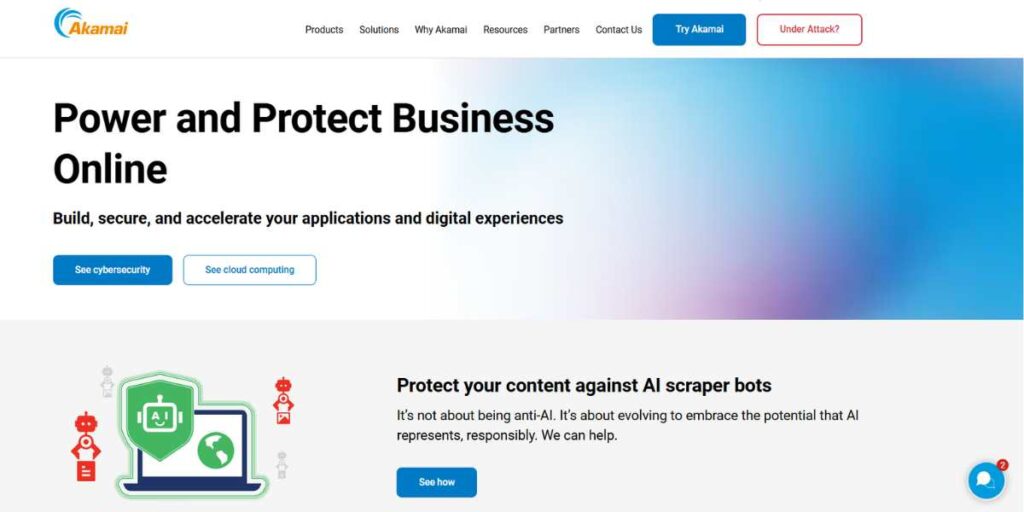
Rating: 4.8/5
Website: https://www.akamai.com/
Akamai Prolexic is the best-in-class way to concede attacks of huge scale, using elements of an immensely large content distribution network to absorb and filter enormous volumes of attacks. It offers robust protection against all manners of DDoS attacks while being cost-effective in its performance delivery to genuine users because of smart traffic routing and analysis. The architecture of Prolexic can withstand multi-terabit attacks without compromising on service, thus suitable for organisations under threat of nation-state or in the face of massive botnets.
Appliance-based DDoS solutions such as Prolexic provide end-to-end managed services including round-the-clock monitoring, professional threat investigation, and instant action against the intruding attacks. The global infrastructure of the solution enables it to offer uniform protection irrespective of where the attack is coming from or where the target.
Key Features:
- Tremendous global infrastructures that can take in terabits of attacks
- The ability to protect against any DDoS attack
- Smart traffic routing and optimization performance features
- Expert-driven threat analysis and response 24/7 managed services
- A worldwide presence with the same level of protection in every location
Pros:
- Incongruency in the processing of exorbitant volumes of attack
- Very good network coverage and good global infrastructure
- Best-in-class managed services and skills competencies
Cons:
- Enterprise-level features/prems
- Multilateral service contracts and deployment conditions
- Possibility of over-engineering to the smaller organizational needs
Pricing: Pricing available upon request based on traffic and protection requirements
9. Corero SmartWall
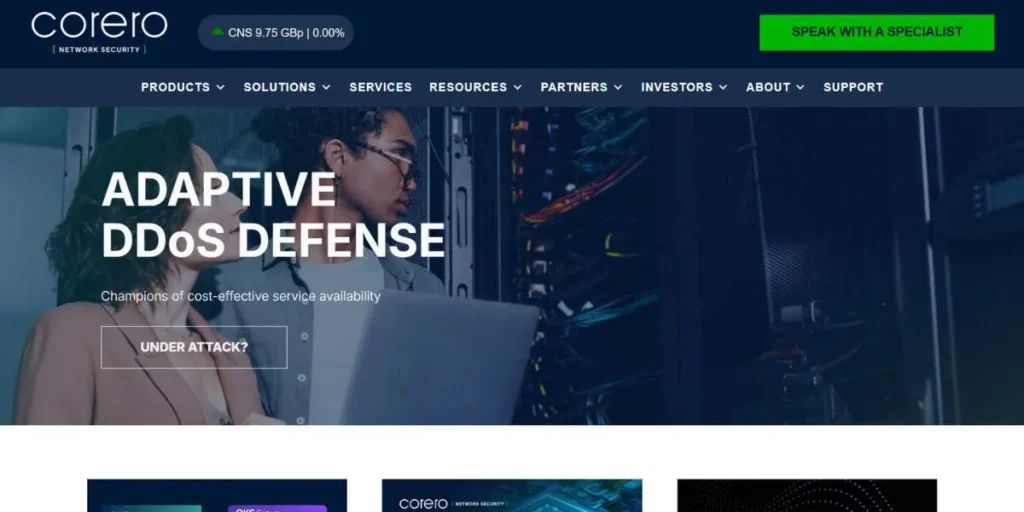
Rating: 4.3/5
Website: https://www.corero.com/
Special attention is devoted to automated fight against the attacks, as Corero SmartWall is used to deliver the real-time DDoS protection with little manual control required. The platform has powerful algorithms in use to differentiate between allowed traffic and malicious trends then automatically enforcing an equivalent countermeasure that has no implications to normal traffic. The architecture of SmartWall was based on the idea of ease of deployment and easy operation thus, this security application is available to companies that lack the expertise and dedicated security operations facilities.
Automated DDoS protection tools such as SmartWall offer significant protection against ever-changing threats as it ensures no growth in operational overheads placed on IT teams as the protection tool also learns and adapts across an ongoing basis. The reporting facilities of the solution give a clear picture of attacks and mitigation effectiveness in the security planning and compliance process.
Key Features:
- Automatic detection of attacks with as little manual execution as possible
- The real time traffic monitoring and smart threat classification
- Simple installation and use by organizations that lack security know-how
- Constant training and adapting to changing levels of threats
- Effective reporting and analysis of visibility and compliance on security
Pros:
- Great automation that minimizes complex operations and requirements
- Easy to navigate and simple implementation procedure
- High cost-efficiency of less-invested companies
Cons:
- Reignited customization experiences in advanced security policies
- Smaller market of presence in comparison to other established enterprise vendors
- Minimal feature compared to full-blown security systems
Pricing: Pricing available upon request based on deployment and capacity requirements
10. Azure DDoS Protection
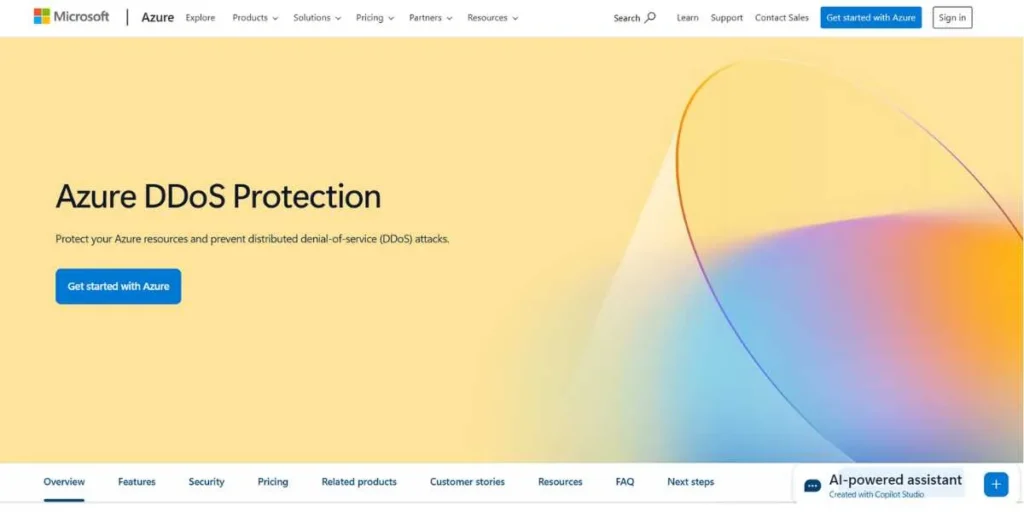
Rating: 4.5/5
Website: https://azure.microsoft.com
Azure DDoS Protection is best fitted to companies who are already invested in using Microsofts cloud and due to its in-depth protection tailored to the Azure platform, organizations can ensure it will best fit their Azure-hosted services and applications. It uses the global network platform of Microsoft to offer continuously-protecting solutions to scale up and scale down in autonomy when dealing with huge numbers of attacks. Azure has inbuilt protection systems, which are integrated with virtual networks and application services, making security seamless and thus there is no need to have any architectural changes or even more complexity added to it.
Such cloud-native DDoS Protection Tools as the Azure DDoS Protection will provide major benefits to companies implementing cloud-first strategies, such as ease of use, automatic maintenance, and compatibility with other security and monitoring tools offered by Azure. The pay-as-you-scale approach that is available with the solution offers affordable protection that scales with their business needs.
Key Features:
- Azure services integration and the virtual network infrastructure
- Continuous security and auto-scaling and threat responses
- Integration with the full production of Azure security and monitoring
- A pay-as-you-scale-based pricing model that matched the pattern of cloud consumption
- Extensive reporting and monitoring of activities
Pros:
- Excellent integration to an organization already utilizing the services of azure
- Easy use of administration tools using well-known Azure administration interfaces
- Scalability that is cost-effective and in line with the patterns of cloud consumption
Cons:
- Low security of non-Azure infrastructure and services
- The reliance on the Microsoft ecosystem in order to enjoy full scale security gains
- Greater barriers on organizations that need to have multi-cloud protection strategies
Pricing: From $3,000/user/month (billed annually) with usage-based pricing available
How to Choose the Right DDoS Protection Tool
The choice of the adequate DDoS protection needs to be thoroughly evaluated based on organizational needs, current infrastructure, and long-term security planning so that the best possible protection could be achieved and investment could pay off.
- Detection: Perform thorough risk analysis of threats, traffic analysis, and the effects of business online attacks.
- Integration: Evaluate whether it will work well with existing security infrastructure, network design and operational procedures in relation to this in line to ensure processes that are smooth to implement.
- Scalability: Take into account the future growth needs, and the capability to support increased traffic and changing threats.
- Budget: Determining the optimality between the protection capabilities and the value of the budget available, first of the initial cost of purchase and then operating cost.
- Expertise: Determine the competencies of the organization to implement, manage, and optimize the selected protection measures.
Conclusion
The quickly developing nature of threats in 2025 requires very complex DDoS Protection Tools which are capable not only to adjust to a more demanding set of attack vectors, but also stay performing optimally on the part of the legal users. When choosing the proper protection means, organizations have to be very attentive in terms of analysis of their individual needs, the currently used infrastructure, and the future security policy. The ten tools that were presented in this detailed review are the best tools within DDoS security currently with individual advantages and features which makes them more appropriate to organizations seeking specific characters and operations.
Protection against DDoS may seem mainly about choosing the appropriate technology but it also depends on the security practice of taking encompassing measures, keeping threat intelligence, and proper integration with the rest of security infrastructure. Increased connectivity is a double-edged sword because it is imperative to deploy strong skills and solutions to support the protection of business processes and digital assets in general, and DDoS Protection Tools in particular, as cyber threats continue to expand in what might be termed as cyber anarchy.
Similar Blogs:
FAQs
What makes DDoS Protection Tools effective in modern attacks?
Using machine learning algorithms, threat intelligence, and behaviors indicators, modern DDoS protection tools would recognize and stop even the most advanced types of attacks that could not be discovered using legacy security deterrence.
What is the difference between off-premise and on-premise DDoS Protection Tools?
DDoS Protection Tools based on the cloud become more scalable, and they are automatically updated, whereas on-premises solutions are more controlled and allow an organization that has specific security needs to be more customized.
Is DDoS Protection Tooling affordable to small businesses at enterprise level?
The benefits of many DDoS Protection Tools are that they have economical scaling pay structures and entry-level plans that do not need considerable upfront costs to enjoy extensive protection by small business.
How fast are the DDoS Protection Tools to react to new attack vectors?
Sophisticated DDoS Defense Tools have the ability to identify and react to new attacks in few seconds with machine driven defense, and also will update protection rules on their networks worldwide.
What are the integration challenges that organizations need to envisage using DDoS Protection Tools?
The task of integration is usually related to changing the DNS settings, traffic routing, and adaptability to the existing systems of protection.

